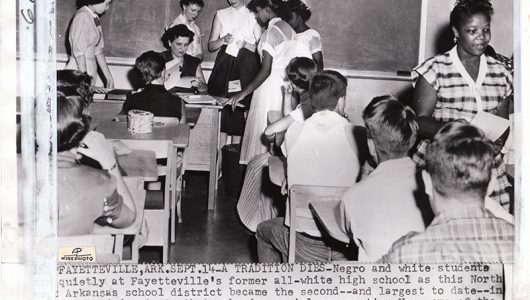Fayetteville High School was one of the state’s first schools to integrate voluntarily without litigation or incident following the U.S. Supreme Court’s landmark Brown v. Topeka (Kan.) Board of Education decision. The district school board voted four days after the court’s May 1954 decision to integrate its high school and junior highs with the start of the fall semester in September. (The Charleston district in Franklin County was the other school system that integrated that fall when its school board voted to proceed with integration a few weeks after the court’s ruling.)
The first Black students entered FHS in a relatively calm atmosphere compared to the confrontation that brought out military troops three years later in Little Rock. David Prater described the situation in the Encyclopedia of Arkansas:
“On September 10, 1954, five black students entered Fayetteville High School. A few days later two more black students entered the school, bringing the total to seven. The only male black student to enroll in classes on September 10, Preston Lackey, entered with the support of white students who had heard rumors of planned violence. Similarly, an Associated Press reporter came prepared to report on violent protests. The only opposition was a lone white woman with a placard.”
A few FUPC families participated in the integration that year. The late Bill Morton, an FUPC member, served on the Fayetteville School Board when it decided to comply immediately with the Brown decision. His son, Bo Morton, is today a member of the congregation. In 2012 Bo Morton participated in a panel discussion at the church about how the congregation and the community responded to the effort. The event was covered in The Morning News on Feb. 8, 2012.
Although only 6 years old at the time, Bo Morton recalled his father’s involvement. “It was a big topic of discussion, and a real source of pride,” he said at the panel. Bill Morton was particularly proud his friend Harry Vandergriff, who was the FHS football coach at the time.
Vandergriff, an FUPC member who would go on to be Fayetteville school superintendent and the namesake of an elementary school, participated in the panel of 10 years ago. He died later that year.
Vandergriff said no Black students tried out for the football team during the first year of integration but two Blacks did so the second year for the 1955 season. Several schools in Fayetteville’s athletics conference refused to play the team if the Black players were present.
“We made it perfectly clear: We were either going to play as a team or we weren’t going to play at all,” Vandergriff said.
Nancy Cole Mays, a current member of the congregation, was an FHS student in 1954. She said it took a while for the event’s significance to become clear.
“We didn’t know we were doing anything special,” Mays said. She told the panel that many class members didn’t realize until their 20-year reunion that they were one of the first integrated graduating classes in the South. She credited the school’s leadership with helping smooth the way.
“People like (principal) Louise Bell and Harry Vandergriff showed us by example how to act,” she said. “Kids are pretty idealistic. If you show them what you expect, point out why you believe like this, they will follow.”


